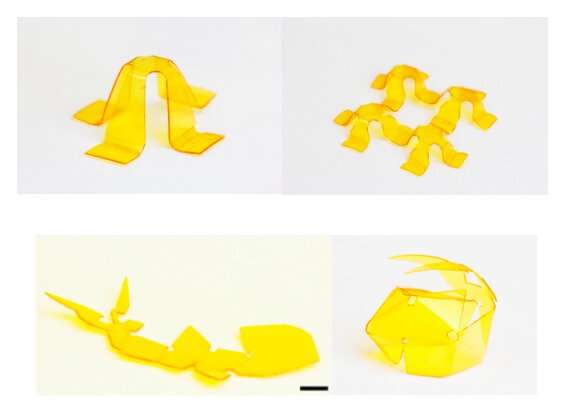April 14, 2020 feature
A new material to print mechanically robust and shape-shifting structures

In recent years, 3-D printing has opened up interesting new possibilities for the large-scale production of electronic components, as well as of a variety of other objects. To this end, research teams worldwide have been trying to create materials and structures that can easily change shape, as these could be particularly useful for 3-D printing applications.
Although many of the programmable and shape-shifting materials developed so far have proved to be promising for 3-D printing, they are often not mechanically robust. This makes them unideal for printing objects that are resistant to a lot of weight or strain.
To overcome this limitation, researchers at Georgia Institute of Technology, Peking University and Beijing Institute of Technology have recently proposed a new shape-morphing material system that is also mechanically robust. This new material, created via the volatilization of a volatile component that has not fully reacted, was presented in a paper published in ACS Applied Materials & Interfaces . The lead authors of this paper are Qiang Zhang and Xiao Kuang.
"In our previous works, we used grayscale digital light processing (gDLP) printing to create shape-morphing structures and inkjet printing to realize direct 4-D printing," Jerry Qi, one of the researchers who carried out the study, told TechXplore. "However, we found that 4-D printing of rapid, on-demand shape-transforming and mechanically robust structures remained a significant challenge."
Drawing inspiration from their previous research findings, Qi and his colleagues devised a volatilization-induced shape morphing mechanism and used it to create a new material system for gDLP printing, containing a reactive and volatilizing component. After it is used to print a given object, the material can rapidly change its shape, through the direct volatilization of the residual monomer at elevated temperatures.
"By controlling the distribution of voxelated shrinkage units enabled by gDLP printing, we were able to achieve on-demand and complex shape-shifting," Qi said. "After shape transforming, we introduced a post-photo curing step to enhance the structures' mechanical properties substantially."
To create the new material presented in their recent paper, the researchers added a highly reactive and volatilizing material to a type of ink that is commonly used in 3-D printing applications. The ink was then solidified using UV light. Interestingly, the resulting solid structure can then be transformed into a variety of new configurations, simply by heating it.
"The structures transformed using the method we developed can then be further mechanically enhanced via additional processing using UV light," Qi said. "We developed a versatile method to access fast shape-changing structures with robust mechanical properties at a low cost, which pushes 4-D printing a step further for practical applications."
The material introduced by Qi and his colleagues has numerous advantages over other shape-shifting materials for 3-D printing introduced in the past. Most notably, it enables the creation of systems that can change their shape on-demand, quickly and with high precision.
In addition, objects or technological components printed using this new material are mechanically robust, which means that they are not as easily damaged by heavy objects or other external forces. In the future, the material and printing technique devised by Qi and his colleagues could enable the 3-D and 4-D printing of numerous different items, including artistic objects, smart devices, deployable electronics, and smart optical devices.
"Our plans for future research include fabricating shape-changing structures of much larger sizes and integrating shape-changing with multiple other functions, such as flexible electronics and optics, to fabricate smart devices, including frequency-tunable antenna, and self-folding RFID," Qi said.
More information: Qiang Zhang et al. Rapid Volatilization Induced Mechanically Robust Shape-Morphing Structures toward 4D Printing, ACS Applied Materials & Interfaces (2020). DOI: 10.1021/acsami.0c02038
Journal information: ACS Applied Materials and Interfaces
© 2020 Science X Network





















